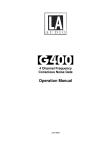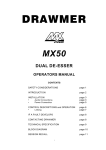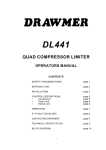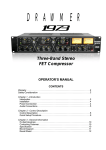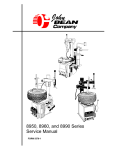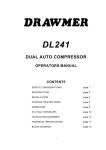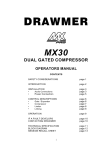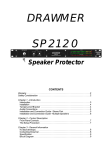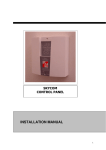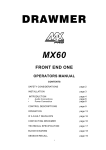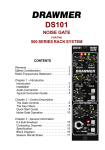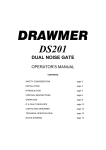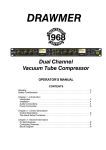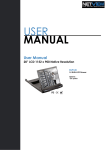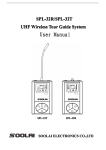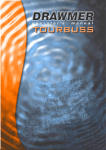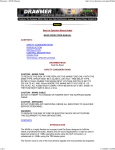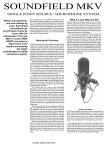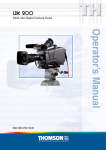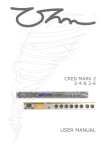Download User Manual
Transcript
DRAWMER SL22 Sound Level Limiter CONTENTS Warranty . . . . . . . . . . . . . . . . . . . . . . . . . . . . . . . . . . . . . . . . . . . . . . . . . . . . 2 Safety Consideration . . . . . . . . . . . . . . . . . . . . . . . . . . . . . . . . . . . . . . . . . . . 2 Installation . . . . . . . . . . . . . . . . . . . . . . . . . . . . . . . . . . . . . . . . . . . . . . . . . . . 3 Power Connection . . . . . . . . . . . . . . . . . . . . . . . . . . . . . . . . . . . . . . . . . . . . . 3 Chapter 1 - Introduction Introduction . . . . . . . . . . . . . . . . . . . . . . . . . . . . . . . . . . . . . . . . . . . . . . . . . 4 Security Plate and Label . . . . . . . . . . . . . . . . . . . . . . . . . . . . . . . . . . . . . . . 6 Tamper-proof Bracket . . . . . . . . . . . . . . . . . . . . . . . . . . . . . . . . . . . . . . . . . 6 Audio Connections . . . . . . . . . . . . . . . . . . . . . . . . . . . . . . . . . . . . . . . . . . . 6 Installation and Connection Guide - Stereo Pair . . . . . . . . . . . . . . . . . . . . 7 Installation and Connection Guide - Multiple Speakers . . . . . . . . . . . . . . . . 7 Chapter 2 - Control Description Control Description . . . . . . . . . . . . . . . . . . . . . . . . . . . . . . . . . . . . . . . . . . . 8 The Setup Procedure . . . . . . . . . . . . . . . . . . . . . . . . . . . . . . . . . . . . . . . . 10 Chapter 3 - General Information If a fault develops . . . . . . . . . . . . . . . . . . . . . . . . . . . . . . . . . . . . . . . . . . . .12 Contacting Drawmer . . . . . . . . . . . . . . . . . . . . . . . . . . . . . . . . . . . . . . . . . .12 Specification . . . . . . . . . . . . . . . . . . . . . . . . . . . . . . . . . . . . . . . . . . . . . . . .12 Block Diagram. . . . . . . . . . . . . . . . . . . . . . . . . . . . . . . . . . . . . . . . . . . . . . .13 COPYRIGHT This manual is copyrighted 2015 by Drawmer Electronics Ltd. With all rights reserved. Under copyright laws, no part of this publication may be reproduced, transmitted, stored in a retrieval system or translated into any language in any form by any means, mechanical, optical, electronic, recording, or otherwise, without the written permission of Drawmer Electronics Ltd. ONE YEAR LIMITED WARRANTY Drawmer Electronics Ltd., warrants the Drawmer SL22 Sound Level Limiter to conform substantially to the specifications of this manual for a period of one year from the original date of purchase when used in accordance with the specifications detailed in this manual. In the case of a valid warranty claim, your sole and exclusive remedy and Drawmer’s entire liability under any theory of liability will be to, at Drawmer’s discretion, repair or replace the product without charge, or, if not possible, to refund the purchase price to you. This warranty is not transferable. It applies only to the original purchaser of the product. DRAWMER SL22 Sound Level Limiter SAFETY CONSIDERATIONS CAUTION - MAINS FUSE For warranty service please call your local Drawmer dealer. Alternatively call Drawmer Electronics Ltd. at +44 (0)1709 527574. Then ship the defective product, with transportation and insurance charges pre-paid, to Drawmer Electronics Ltd., Coleman Street, Parkgate, Rotherham, S62 6EL UK. Write the RA number in large letters in a prominent position on the shipping box. Enclose your name, address, telephone number, copy of the original sales invoice and a detailed description of the problem. Drawmer will not accept responsibility for loss or damage during transit. TO REDUCE THE RISK OF FIRE REPLACE THE MAINS FUSE ONLY WITH A FUSE THAT CONFORMS TO IEC127-2. 250 VOLT WORKING, TIME DELAY TYPE AND BODY SIZE OF 20mm x 5mm. THE MAINS INPUT FUSE MUST BE RATED AT 230V=T63mA and 115V=T125mA. This warranty is void if the product has been damaged by misuse, modification or unauthorised repair. CAUTION - MAINS CABLE THIS WARRANTY IS IN LIEU OF ALL WARRANTIES, WHETHER ORAL OR WRITTEN, EXPRESSED, IMPLIED OR STATUTORY. DRAWMER MAKES NO OTHER WARRANTY EITHER EXPRESS OR IMPLIED, INCLUDING, WITHOUT LIMITATION, ANY IMPLIED WARRANTIES OF MERCHANTABILITY, FITNESS FOR A PARTICULAR PURPOSE, OR NON-INFRINGEMENT. PURCHASER’S SOLE AND EXCLUSIVE REMEDY UNDER THIS WARRANTY SHALL BE REPAIR OR REPLACEMENT AS SPECIFIED HEREIN. IN NO EVENT WILL DRAWMER ELECTRONICS LTD. BE LIABLE FOR ANY DIRECT, INDIRECT, SPECIAL, INCIDENTAL OR CONSEQUENTIAL DAMAGES RESULTING FROM ANY DEFECT IN THE PRODUCT, INCLUDING LOST PROFITS, DAMAGE TO PROPERTY, AND, TO THE EXTENT PERMITTED BY LAW, DAMAGE FOR PERSONAL INJURY, EVEN IF DRAWMER HAS BEEN ADVISED OF THE POSSIBILITY OF SUCH DAMAGES. DO NOT ATTEMPT TO CHANGE OR TAMPER WITH THE SUPPLIED MAINS CABLE. CAUTION - SERVICING DO NOT PERFORM ANY SERVICING. REFER ALL SERVICING TO QUALIFIED SERVICE PERSONNEL. WARNING TO REDUCE THE RISK OF FIRE OR ELECTRIC SHOCK DO NOT EXPOSE THIS EQUIPMENT TO RAIN OR MOISTURE. Some states and specific countries do not allow the exclusion of implied warranties or limitations on how long an implied warranty may last, so the above limitations may not apply to you. This warranty gives you specific legal rights. You may have additional rights that vary from state to state, and country to country. It is the responsibility of the installer to ensure that the continuous power rating of the speakers is not exceeded, as Drawmer Electronics Ltd will not accept any responsibility for damage caused by incorrect installation and settings. In the interests of product development, Drawmer reserve the right to modify or improve specifications of this product at any time, without prior notice. 2 CHAPTER 1 INSTALLATION The SL22 Sound Level Limiter is designed for standard 19" rack mounting and occupies 1U of rack space. Where possible, avoid mounting the unit directly above power amplifiers or power supplies that radiate significant amounts of heat. If the unit is to be used in a mobile situation, it is strongly recommended that the rear of the unit is supported in the carrying rack to avoid bending the front panel rack mounting ‘ears’. Use fibre or plastic washers to prevent the front panel becoming marked by the mounting bolts. Always connect the mains earth to the unit. Fig. 2 shows the ideal connection setup, providing the greatest protection for your system. Note the position of the SL22 along the audio chain - it should be connected directly before the amplifier that is supplying the speakers, (or before the active speakers), with the amplifier volume set to maximum. If the SL22 were to be connected earlier in the chain, prior to the pre-amp/mixer for example, then it would be possible to add gain, sending noise levels higher than required. The SL22 can be used in a configuration where a stereo output is distributed around several speakers. Fig.3 shows a setup where the signal is distributed into six pairs using a Drawmer DA6, whilst still providing speaker protection for all twelve speakers. Again, note the position of the SL22’s along the audio chain - they should all be connected directly before the amplifier that is supplying the speakers (or active speakers), with the amplifier volume set to maximum. POWER CONNECTION The SL22 unit will be supplied with a power cable suitable for domestic power outlets in your country. For your own safety, it is important that you use this cable to connect to the mains supply earth. The cable must not be tampered with or modified. The SL22 has an internal fuse to suit the mains voltage for which the unit has been supplied. The fuse should never blow under normal operation. If the fuse is suspected of having blown, then a fault will have occurred and this fault condition should be inspected by a qualified service engineer. When replacing the fuse, always comply with the Safety Instructions. If the unit is to be used with a mains input operating voltage different to that for which the unit is supplied, the following procedure must be carried out by a technically competent person: 1: Disconnect the unit from the mains. 2: Using a number 1 size pozidrive screwdriver, remove the seven self-tapping screws that retain the top cover. Two screws are found along each side, two at the rear along the top lip, and one on the front panel, centre top. 3: With the cover removed slide the voltage change-over switch (VS1) until the correct (or nearest) mains input voltage is visible on the switch actuator. The switch is located to the top right of the main circuit board between the mains I.E.C. and toroidal transformer. For conversion to 115Volt AC (previously set to 230Volt AC)..... 4a: Exchange the 63mA fuse adjacent (FUSE1) for a similar type rated at 125mA For conversion to 230Volt AC (previously set to 115Volt AC)..... 4b: Exchange the 125mA fuse adjacent (FUSE1) for a similar type rated at 63mA In all cases: 5: Replace the top cover using the seven screws. 6: Re-connect to mains power source. 3 DRAWMER SL22 SOUND LEVEL LIMITER INTRODUCTION Safeguard Your Hearing, Protect Your Speakers, and Conform to Regulations! Whether you need to protect your speakers, your hearing whilst listening to headphones or your premises license the Drawmer SL22 Sound Level Limiter is the perfect tool for the job. By eliminating the possibility of ’unauthorised’ excessive sound pressure levels it offers strict level control and tremendous peace of mind to users in three distinct areas: 1 2 3 SAFEGUARD YOUR HEARING CONFORM TO REGULATIONS PROTECT YOUR SPEAKERS Conform to Noise at Work Regulations by controlling user’s exposure to audio whilst at work to help prevent hearing damage By calibrating and controlling venue noise levels and in a secure manner you conform to Local Authority Noise Regulations Prevents the damage to speaker chassis drivers and amplifier electronics by catching unwanted signals such as ‘bangs’ and ‘pops’ Benefiting from Drawmer’s 30 years involvement in designing industry standard dynamic processing devices, and especially the experience gained from its sister product, the popular SP2120 Speaker Protector, the SL22 has been designed to be more versatile and feature rich but at the same time just as easy to set up. The key features are as follows: • Limited speaker and headphone outputs. • Once installed and calibrated completely eliminates the possibility of ’unauthorised’ volume levels • No sound quality loss even during protection processing • Large LED level indication for ’at a glance’ monitoring of signals and warnings • Time delay relays on outputs for clean power up/down • Fast, simple installation. • Tamper-proof plate limits access to settings. • A security label is supplied to further secure the calibration settings and show evidence of tampering. • Tamper-Proof bracket (available separately) to lock-in the XLR’s and conform to Local Authority regulations. • Reduces ’call-out’ costs of sound system service/repair engineers, sound system ’down time’ and the consequential loss of venue income, as well as the reputation of the venue. • External control of Dim and Mute for connection to Fire Alarms or remote operation • Trigger output when in PROTECT mode • Logging inputs for both ALERT and PROTECT statuses. The SL22 front panel features an integral security plate to ensure that adjustments to maximum volume levels are implemented by authorised personnel only. Once removed two front panel pre-sets are exposed and available for adjustment by the installer. The first calibrates the protect indication to the incoming audio and dictates the point at which ’protection’ processing commences. The second sets the absolute volume level to which the sound system is 4 allowed to perform. If the SL22 receives increased signal levels, the transparent ’protection’ circuitry is activated which maintains the specified system volume level without degradation in sound quality. With the security plate replaced a security label can be placed across (supplied) to provide further security and show evidence of tampering with the settings. In addition, on the right side of the panel three LED indicators complement the simple setup with simple and ‘at a glance’ monitoring. To the rear the difference between the SL22 and the SP2120 is just as apparent. In its development we liaised with and were approached by local authority commissioners, installation specialists and venue owners who all advised and recommended attributes to suit their own specific requirements, the result being the addition many more versatile features that so many other sound level limiters lack. As well as the standard input and output XLRs (that can be securely locked using the optional tamperproof bracket) the SL22 also features a limited headphone output, that works in the same manner as the XLR’s, plus the ability to be controlled externally via a fire alarm or operator, and also connections to allow data logging of the SL22’s operation, or external visual indication via a light on a wall, for example. 1 - SAFEGUARD YOUR HEARING As the SL22 offers the ability to calibrate and control the level of the dedicated headphone output in just the same way as the speaker outputs it can be used to prevent hearing damage to anyone wearing headphones on a regular basis - DJ’s, sound engineers in recording studio’s, students listening to audio via various media. As well as the dedicated headphone output the SL22 has additional connectors on the rear that can be used for remote data logging of its operation, or to operate external indicator’s, such as signals on the wall. Development of the SL22 and Noise at Work The development of the SL22 has been undertaken in conjunction with a multi-national media company needing to conform to Noise At Work Legislation and protect the hearing of the DJ’s in their radio studios. During testing they had become very disillusioned by the current products on offer, finding that they were either so crude that they didn’t really work, or, at best, the attenuation could be heard and was intrusive. Many products were tried, and a few experiments, and concluded that the SP2120 was the most transparent product on the market, it just required a few adaptations to fully suit their requirements - the SL22 is the result of this development. 2 - CONFORM TO REGULATIONS As well as protecting the equipment the precise calibration and volume controlling of the SL22 allows venues, such as clubs, theatres, pubs, schools, universities etc. to conform to Local Authority Noise Regulations. The concept and development of the original Speaker Protector was encouraged by Drawmer distributors and installers dissatisfied with other protection systems currently available (these often take the form of a crude switch, either turning off the power or disconnecting the speakers, both of which are ’disruptive’ in any event), and the SL22 has taken these ideas and developed them still further. The SL22 offers the same protection, but also is more responsive and versatile. The controls are only accessible by those holding the supplied tamper-proof screwdriver, and the rear panel XLR’s can be ‘locked away’ using the optional tamper-proof bracket - making tampering with the volume levels extremely difficult. In addition, the SL22 has the facility to be controlled remotely, meaning that a manager can attenuate or mute the volume as required, or it can be connected directly to a fire alarm, reducing the volume automatically during a fire and allowing the alarm to be heard more clearly. 3 - PROTECT YOUR SPEAKERS Whether in a large arena with a p.a. system and multiple speakers, or smaller venues such as bars and theatres, there are few things more annoying and troublesome than blowing a speaker cone or amplifier electronics. There are several possible causes for the sound pressure level to rise: it could be caused by sudden spikes and pops in the system; it may be that the amplifier is too powerful or the speakers have too low a rating and increasing the volume overloads the speakers; sudden clipping in the audio signal chain causing a sine wave; in a venue an over enthusiastic DJ may just turn up every knob to get the gig as load as possible: whatever the reason, unlike standard compressor/ limiters, the SL22 has been specifically designed to transparently catch those unwanted SPL’s and protect your gear. Not only will it save money by reducing the cost of speaker repairs, but also reduce ’call-out’ costs of sound system service/repair engineers, lower sound system ’down time’ and the consequential loss of venue income, as well as the reputation of the venue. 5 SECURITY PLATE & LABEL The front panel has a plate on the front under-which the two calibration controls sit. This is secured using M3 TORX tamperproof screws. A screwdriver is supplied to remove this plate, as well as a tamper-proof label that further secures the SL22’s settings. Once the front panel security plate has been replaced, after the calibration process has finished, the label can be placed across so that it adheres to both the plate and the front panel. If the security plate is tampered with and the label touched it will leave a ‘void’ identification, showing that the settings have potentially been altered and that calibration must be performed again. TAMPER-PROOF BRACKET Drawmer have gone to great lengths to make the SL22 tamper-proof by incorporating the locking plate with tamper-proof screws on the front. However, if the rear of the unit, along with the power amplifier, were reconnected then the protection system would effectively be bypassed. For this reason Drawmer have designed the Tamperproof Bracket - trapping the XLR’s in place and making it extremely difficult to disconnect them without removing the bracket. This bracket could be specified in order to conform to Local Authority noise abatement regulations. Installation of the Tamper-proof bracket could not be simpler: After setting up the SL22 as described in this manual, with the XLR’s in place, simply slide the Tamperproof Bracket over the rear of the unit, making sure that the XLR cables locate through the gaps on the bracket. Next, screw in to place at the four locating points (arrowed below) using the M3 screws provided. Further protection can be gained by fitting M3 TORX tamperproof screws, to a maximum length of 6mm, the same as used on the front, and utilizing the same tamperproof screwdriver. In addition, for extra protection, both the SL22 and the power amp should be locked in a rack, where access to the rear is very difficult. AUDIO CONNECTIONS The inputs and outputs are electronically balanced on conventionally wired XLRs (pin 1 screen, pin 2 hot, pin 3 cold and XLR shell is connected to chassis). Balanced use is recommended. • Interference: If the unit is to be used where it maybe exposed to high levels of disturbance such as found close to a TV or radio transmitter, we advise that the unit is operated in a balanced configuration. The screens of the signal cables should be connected to the chassis connection on the XLR connector as opposed to connecting to pin1. The 4X4 conforms to the EMC standards. 6 • Ground Loops: If ground loop problems are encountered, never disconnect t he mains earth, but inst ead, try disconnecting the signal screen on one end of each of the cables connecting the outputs of the 4X4 to the patchbay. If such measures are necessary, balanced operation is recommended. INSTALLATION AND CONNECTION GUIDE - Stereo Pair (fig.2) INSTALLATION AND CONNECTION GUIDE - Multiple Speakers (fig.3) In a configuration where a stereo output is distributed around several speakers individual SL22’s and their setup procedure should be used for each speaker pair. 7 CHAPTER 2 CONTROL DESCRIPTION ACCESS TO CONTROLS A & B Once the SL22 is connected it is remarkably easy to set up having only two adjustable controls. These are placed on the left side of the front panel behind a security plate. Tamper-proof screws are used to hold the plate to make unaurthorised adjustment to the settings very difficult. Access the controls by removing the two tamper-proof TORX screws that holds the plate using the tamper-proof screwdriver supplied. Once set up the plate should be replaced using the tamper-proof screws. A security label can be placed across the plate to further secure the settings. A THRESHOLD The threshold control sets the signal level at which the SL22 limiter circuit (protect) triggers. B MAX VOLUME Set the maximum volume that you wish the audio signal to reach - the output level leaving the SL22 will not rise above this level. If you wish to protect your speakers from pops and bangs simply set the audio levels to that which you are comfortable, or those within the specifications of you music system. However, in order to comply with noise at work and local authority noise regulations the output volume level should be calibrated (see calibration section). C SIGNAL W hen lit identifies that an audio signal is present but is not being limited. If the SL22 is connected correctly but no led is lit then an error has occurred within the audio signal path and should be investigated. D ALERT The Alert LED lights when the signal level is within 6dB’s of the threshold level at which the signal will begin to be limited (i.e. protection occurs). The LED acts as a warning and at this point no limiting is occurring. The level set can be written in the white box underneath E PROTECT When lit identifies that the level of the audio signal has passed threshold and the SL22 is limiting the level of the signal in order to protect the speakers, the hearing of the listeners or complying to noise regulations. The level set can be written in the white box underneath. 8 F POWER LED When lit indicates that the SL22 unit is switched on. G LEFT CHANNEL INPUT / OUTPUT The left channel from the mixing desk/console/pre-amplifier etc. should connect to the input here. The output should connect directly with the left channel Active Monitor/ Amplifier & Speaker. Once leaving the SL22 this signal can be attenuated, but no gain should be added. Balanced connections are recommended. H RIGHT CHANNEL INPUT / OUTPUT The right channel from the mixing desk/console/pre-amplifier etc. should connect to the input here. The output should connect directly with the right channel Active Monitor/ Amplifier & Speaker. Once leaving the SL22 this signal can be attenuated, but no gain should be added. Balanced connections are recommended. I HEADPHONE OUTPUT A 1/4” stereo headphone output is provided on the rear panel. This limits the audio in the same way as the channel outputs and will protect your hearing and headphones in an identical manner. In order to comply with noise at work regulations and to protect your hearing to maximum listening levels the headphone volume level should be calibrated (see calibration section). J EXTERNAL / FIRE ALARM I/P The ability to have some external control over volume levels has been provided via these connectors. DIM - when activated attenuates the signal volume by 20dB. In other words, DIM lowers the Max Volume control setting by 20dBs - and so the SL22 will still protect in exactly the same manner. MUTE - when activated attenuates the signal volume by 70dB. The uses for this facility are widespread and could be used to allow for voice overs to be heard more clearly, for example, or to lower the volumes of a nightclub at certain times to comply to local authority noise regulations. A Fire Alarm could be connected directly to the SL22 via these connections to attenuate or mute the audio and allow for the alarm to be heard more clearly in the case of a fire. In order to trigger either connection the circuit has to be closed externally - this can be done in the form of a physical switch, or via relays etc. The connections are via bare wire screwing terminal blocks. Contact the Drawmer technical department for further information. K EXTERNAL INDICATOR OUTPUT Facilitates the use of external indicators that provide a visual reflection of the level of limiting that is occurring within the SL22. They could be connected to a light on a wall or office, or more sophisticated instrumentation. As well as visual indication, the External Indicator Outputs could also be used for data logging to help further adhere to noise at work regulations. ALERT and PROTECT are isolated solid state relays which switch on in conjunction with the corresponding LEDs on the front panel. In order to operate external power of a maximum 24V at 50mA should be applied across the terminals by the external indicator. TRIGGER operates in conjunction with the Protect LED indication on the front panel. It differs from the Alert and Protect connectors in that it supplies its own power of 5V and could be used to trigger an external warning device. The connections are via bare wire screwing terminal blocks. Contact the Drawmer technical department for further information. 9 THE SETUP PROCEDURE 1 - Simple Setup to Protect Speakers Use the following procedure to setup your system so that the SL22 protects speakers and amplifiers. a. Ensure that the system is connected correctly and that both the SL22 and the amplifier that follows it are locked in a cabinet where access is limited. b. Using the screwdriver provided unscrew the front cover plate to provide access the calibration controls. c. Using a small screwdriver turn the calibrate controls “Threshold” and “Max Volume” fully anti-clockwise to the minimum position. d. Turn the level on the power amp or active speaker to its maximum gain level. e. Playing test tones at -0dBu or a loud piece of music, that will provide high input levels to the SL22, rotate the “Max Volume” control until the noise levels from the power amp reaches the maximum level that can be tolerated by the equipment, or your hearing (whichever is lowest). f. Rotate the “Threshold” control until the Alert led is illuminated and the Protect indicator led turns on only on signal peaks - in this way even if the input levels are increased, by ‘bangs and pops’ for example, this noise level will never be exceeded. g. Replace the front panel cover plate. 2 - Setup to Calibrate Noise Levels over Speakers to Comply with Local Authority and Noise at Work Legislation Use the following procedure to setup your system so that the SL22 provides calibrated noise levels that conform to those set by local authorities, and noise at work regulations. In addition, the same procedure will provide protection for speakers and amplifiers. In a configuration where a stereo output is distributed around several speakers the setup procedure should be used for each speaker pair. a. Ensure that the system is connected correctly and that both the SL22 and the amplifier that follows it are locked in a cabinet where access is limited. b. Using the screwdriver provided unscrew the front cover plate to provide access the calibration controls. c. Using a small screwdriver turn the calibrate controls “Threshold” and “Max Volume” fully anti-clockwise to the minimum position. d. Turn the level on the power amp or active speaker to its maximum gain level. e. Playing test tones at 0dBu, a loud piece of music that will provide high input levels to the SL22, or audio that the local authority inspector has provided/recommended, rotate the “Max Volume” until the desired reading is achieved on the SPL meter. f. Rotate the “Threshold” control until the Alert led is illuminated and the Protect indicator led turns on only on signal peaks - in this way even if the input levels are increased, by an over-enthusiastic DJ, for example, this noise level will never be exceeded. g. Replace the front panel cover plate using the TORX tamperproof screws provided. h.If required, for increased security, or if regulations recommend it, fit a Drawmer Tamper-Proof Bracket to the rear (avaliable separately) and a void label to the front panel coverplate (supplied). i. Lock the cabinet that the SL22 and amplifier are in. 10 Sound Pressure Level (SPL) Meter: Whether you are calibrating your environment to comply with noise regulations or simply to protect speakers it would be impossible to measure the level of sound by ears alone so the purchase of a Sound Pressure Level meter is necessary. Meters by companies such as Galaxy, Gold Line, Nady etc. are recommended but in all cases they should have the industry standard “C-weighted” curve, slow setting. Refer to your meter’s manual to learn how to measure within the environment and select the settings. If all else fails there are iphone/Android apps that claim to be SPL meters - whilst these are nowhere near the quality of a dedicated meter they are better than nothing. Test files: Test tones/calibration files can be downloaded from the Drawmer website on the S L22 pag e at: www.drawmer\products\protection\sl22_sound_level_limiter.php or the internet if you search around: wav files are preferred to mp3’s due to the compression/limited frequency range of mp3’s. You can also purchase good quality reference CD’s/ DVD’s from various stores. The recommended tones required for calibration are: 3. Full-bandwidth pink-noise file recorded at 0dBu. 2. 40Hz to 80Hz bandwidth limited pink-noise file recorded at 0dBu. 3. 500Hz to 2500Hz bandwidth limited pink-noise file recorded at 0dBu. 3 - Setup to Calibrate Noise Levels over Headphones to Comply with Noise at Work Legislation The SL22 has a single headphone output that is limited in the same way as the speakers. Use the following procedure to setup your headphones so that the SL22 provides calibrated noise levels that conform to noise at work regulations. a. Ensure that the system is connected correctly and that the access to the both the SL22 and the headphone amplifier/ distributor that follows is limited. Plug the headphones (or the headphone amplifier/distributor) into the headphone socket on the rear of the SL22. Note that the volume for the headphones should occur prior to the SL22 - so if gain can be applied via a headphone amplifier this must be set to maximum so that it could only attenuate the volume. b. Using the screwdriver provided unscrew the front cover plate to provide access the calibration controls. Using an SPL meter to Calibrate Headphone Noise Levels The recommended method of measuring the SPL of headphones, that is accurate enough to work to ISO 119042 standards, is to use a meter coupler inserted into an acoustic manikin, commonly known as a dummy head. This best replicates a head wearing headphones, and is the most accurate. However, this is very specialist equipment, is expensive and often impractical for somewhere like a call centre, radio station or recording studio to setup. A simple, and less costly method of measuring the SPL is to insert a disc to the end of the meter, to provide a seal around the headphone cup, with the meter sensor protruding inside the cup to provide the reading. Though not quite as accurate, it will be reasonably exact. c. Using a small flat headed screwdriver turn the calibrate controls “Threshold” and “Max Volume” fully anti-clockwise to the minimum position. d. Turn the incoming level to the SL22 to its maximum gain level. e. With the SPL meter measuring the headphones (see: Using an SPL meter to Calibrate Headphone Noise Levels) play test tones at 0dBu or a loud piece of music that will provide high input levels to the SL22, rotate the “Max Volume” until the desired reading is achieved on the SPL meter. f. Rotate the “Threshold” control until the Alert led is illuminated and the Protect indicator led turns on only on signal peaks - in this way even if the input levels are increased, by a DJ wanting more volume, for example, this noise level will never be exceeded, and so protect his ears g. Replace the front panel cover plate using the TORX tamperproof screws provided. Finally: In all cases test the system by increasing gain from the mixing desk (or anywhere preceding the SL22 in the audio chain) as you increase the level the Protect LED should become more active but the overall signal level of the system will remain within the set parameters. Setting the Calibration Levels of Speakers and Headphones for Simultaneous Use In the real world it is difficult to exactly match the speaker volume to those in the headphones, and will be very dependant on the sensitivity of the headphones used, as well as other factors. It is simpler to calibrate via one or the other depending on the environment (calibrate on speakers within a nightclub, and headphones for a radio DJ, for example), however, if it is imperative that the volume of the speakers and headphones match, e.g. in a studio for mastering purposes, most amplifiers or active speakers will have a trimmer that allows the signal to be attenuated. If not, there is a facility within the SL22 to do this - contact Drawmer for more information. 11 CHAPTER 3 GENERAL INFORMATION It is the responsibility of the installer to ensure that the continuous power rating of the speakers is not exceeded, as Drawmer Electronics Ltd will not accept any responsibility for damage caused by incorrect installation and settings. IF A FAULT DEVELOPS CONTACTING DRAWMER For warranty service please call Drawmer Electronics Ltd. or their nearest authorised service facility, giving full details of the difficulty. Drawmer Electronics Ltd., will be pleased to answer all ap plic atio n qu estion s to enh an ce you r usag e of this equipment. Please address correspondence to: A list of all main dealers can be found on the Drawmer webpages. On receipt of this information, service or shipping instructions will be forwarded to you. No equipment should be returned under the warranty without prior consent from Drawmer or their authorised representative. For service claims under the warranty agreement a service Returns Authorisation (RA) number will be issued. Write this RA number in large letters in a prominent position on the shipping box. Enclose your name, address, telephone number, copy of the original sales invoice and a detailed description of the problem. Authorised returns should be prepaid and must be insured. Drawmer (Technical Help line) Coleman Street Parkgate Rotherham S62 6EL UK Alternatively contact us by E-mail on : [email protected] Further information on all Drawmer dealers, Authorised service departments and other contact information can be obtained from our web pages on: http://www.drawmer.com All Drawmer products are packaged in specially designed containers for protection. If the unit is to be returned, the original container must be used. If this container is not available, then the equipment should be packaged in substantial shock-proof material, capable of withstanding the handling for the transit. SL22 Sound Level Limiter DATA SPECIFICATION INPUT Input Impedance Power Requirements115Volt or 230Volt at 50-60Hz, 9VA 20k Ohms Fuse CONFORMS TO IEC127-2. 230V=T63mA, 115V=T125mA. Dimensions 482mm(W) x 44mm (H) x 190mm(D) Weight 2.2kg OUTPUT Output Impedance Headphone Output Impedance Gain Range @ Output Recommended Output Level 100R 110R -30dBu to +44dBu 0dBu Crosstalk > 90dB at 10k Hz Noise -93.5dB (Unity gain / 22Hz-22kHz) 12 BLOCK DIAGRAM SL22 ver 01 A 11/02/15 13













